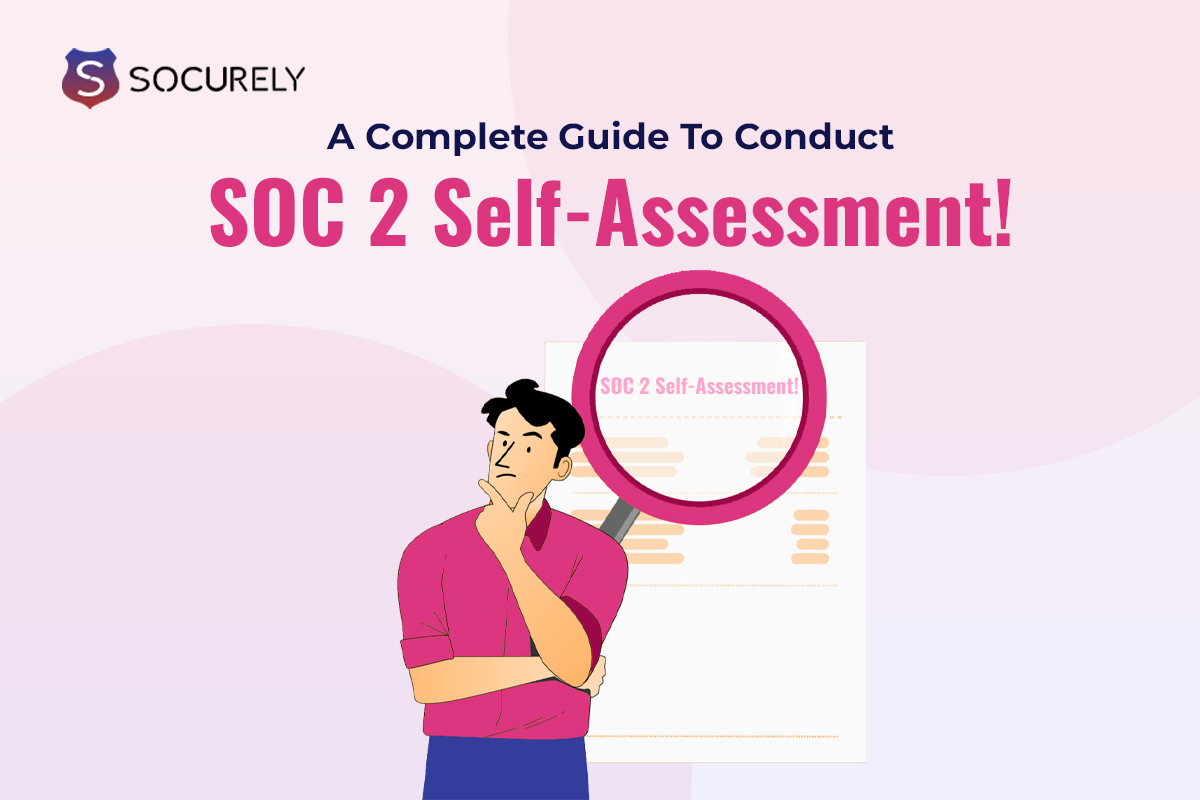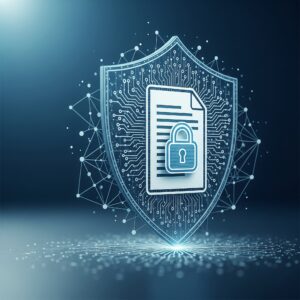According to a report by the Ponemon Institute, 63% of organizations experienced a data breach in the past two years, and the average cost of a data breach is $3.92 million.
SOC 2 compliance is quickly becoming essential, especially for companies in their early stages, to avoid possible losses. Getting your SOC 2 is no more a question of why you should, but rather when. Nevertheless, getting ready for SOC 2 might take some time. In that case, how and when do you know to halt and do your audit while you navigate the hoops to become SOC 2 compliant? How can you determine if you are prepared for an audit without paying a large sum of money to a third-party consultant?
For all your queries, the method that can be effective is called SOC 2 self-assessment! It is like SOC 2 readiness evaluation but without the added expense!
SOC 2 Self-Assessment
A SOC 2 self-assessment evaluates your organization’s existing controls and processes against the SOC 2 criteria. This proactive approach helps identify areas for improvement before undergoing a formal audit. It is a cost-effective way to prepare for SOC 2 audit and ensures that your organization is well-equipped to handle data security challenges.
**Also read about SOC 2 Types like SOC 2 Type 1 Compliance and SOC 2 Type 2 Compliance.
Conduct SOC 2 Self-Assessment- 8 Effective Steps
- Establish An Internal SOC 2 Team
Form a Dedicated Team: Assemble a team of key stakeholders, including IT personnel, compliance officers, and department heads. This team will be responsible for overseeing the self-assessment process.
Assign Roles and Responsibilities: Clearly define the roles and responsibilities of each team member. Ensure that everyone understands their tasks and the importance of their contribution to the assessment.
- Understand the SOC 2 Criteria
Familiarize with Trust Service Principles: Thoroughly understand the five trust service principles: security, availability, processing integrity, confidentiality, and privacy. Each principle has specific criteria that need to be met.
Review SOC 2 Reports: Analyze SOC 2 Reports from similar organizations or previous audits to gain insights into common areas of focus and potential pitfalls.
- Conduct a Risk Assessment
Identify Risks: Perform a comprehensive risk assessment to identify potential threats to your organization’s information security. Consider both internal and external risks.
Evaluate Controls: Assess the effectiveness of existing controls in mitigating identified risks. Assess whether any further controls need to be put in place.
Put Risks First: Sort hazards according to their likelihood and possible impact. Prioritize taking care of the most important risks first.
- Gap Analysis
Compare Current State to SOC 2 Criteria: Conduct a gap analysis by comparing your current controls and processes against the SOC 2 criteria. Assess the areas in which your organization needs to improve.
Document Findings: Maintain detailed documentation of gaps and areas for improvement. This will serve as a roadmap for the self-assessment process.
- Develop an Action Plan
Create a Remediation Plan: Develop a comprehensive remediation plan to address identified gaps. Outline specific actions, assign responsibilities, and set deadlines for completion.
Implement Controls: Implement new controls or enhance existing ones to meet SOC 2 criteria. Ensure that these controls are integrated seamlessly into your organization’s processes.
Monitor Progress: Regularly review the progress of remediation efforts. Maintain a trackable action plan by adjusting it as necessary.
- Conduct Internal Audits
Perform Internal Audits: Conduct internal audits to evaluate the effectiveness of implemented controls. This helps ensure that the controls are functioning as intended and meeting SOC 2 requirements.
Document Audit Findings: Document the results of internal audits, including any identified issues and corrective actions taken. This documentation is essential for demonstrating compliance during the external audit.
- Continuous Monitoring and Improvement
Implement Continuous Monitoring: Establish a system for continuous monitoring of controls and processes. With this measure, you can further address any issues and risks seamlessly.
Review and Update Policies: Regularly review and update security policies and procedures to reflect changes in the organization or the threat landscape.
Conduct Regular Training: Provide ongoing training to employees on SOC 2 compliance and security best practices. This helps maintain a culture of security awareness within the organization.
- Preparing for External Audit
Select an Independent Auditor: Choose a reputable, independent auditor to conduct the external SOC 2 audit. Ensure that the auditor has experience with SOC 2 assessments.
Conduct Pre-Audit Assessments: Perform pre-audit assessments to identify and address any remaining issues before the formal audit. This increases the likelihood of a successful audit outcome.
Compile Documentation: Gather all necessary documentation, including policies, procedures, and audit findings, to present to the auditor.
Why SOC 2 Self Assessment Is Important?
Proactive Identification of Vulnerabilities
Conducting a SOC 2 self-assessment helps identify potential weaknesses and vulnerabilities in your current security measures. By addressing these issues proactively, you can avoid security breaches and non-compliance penalties.
Improved Preparedness for External Audits
A thorough self-assessment prepares your organization for the external audit by identifying and addressing compliance gaps. This reduces the likelihood of surprises during the audit process and increases the chances of a successful outcome.
Cost-Effective Compliance
Identifying and resolving issues internally is often more cost-effective than relying solely on external auditors to find and fix problems. This approach allows you to allocate resources more efficiently and reduce overall compliance costs.
Enhanced Stakeholder Confidence
Demonstrating a proactive approach to SOC 2 compliance builds confidence among customers, partners, and stakeholders. It shows your commitment to data security and can enhance your organization’s reputation and trustworthiness.
Benefits of SOC 2 Self-Assessment
- Enhanced Security Posture: By conducting a self-assessment, you can identify and address vulnerabilities in your controls, thereby strengthening your overall security posture.
- Improved Preparedness for External Audit: A thorough self-assessment helps you prepare for the external audit, reducing the risk of non-compliance and audit failures.
- Cost Savings: Identifying and addressing issues internally can be more cost-effective than relying solely on external auditors to find and fix problems.
- Increased Stakeholder Confidence: Demonstrating a proactive approach to SOC 2 compliance can enhance the confidence of customers, partners, and stakeholders in your organization’s commitment to data security.
What You Need To Conduct A SOC 2 Self-Assessment?
To conduct the SOC 2 Self Assessment, you will need the following must-haves:
- Begin the process of self-evaluation months before the SOC 2 Audit.
- Verify the subject matter knowledge of your staff members.
- Obtain a committed SOC 2 team that is well-versed in the self-assessment process.
- Assemble some paperwork, regulations, and instruments for risk assessments.
Challenges In SOC 2 Self-Assessment
Resource Allocation: Conducting a thorough self-assessment requires significant time and resources. Balancing this with other business priorities can be challenging.
Continuous Improvement: Maintaining compliance is an ongoing process that requires continuous monitoring and improvement. Organizations must be prepared to invest in ongoing efforts to stay compliant.
Balancing Security and Usability: Implementing stringent security controls can sometimes impact the usability and efficiency of business processes. Finding the right balance is essential.
How Socurely Helps?
Socurely is dedicated to simplifying the complex world of SOC 2 compliance. Our platform provides an intuitive, automated solution for conducting SOC 2 self-assessments and achieving compliance.
Key Features of Socurely’s SOC 2 Compliance Solution
Automated Assessments: Socurely’s platform automates the self-assessment process, reducing manual effort and increasing accuracy.
Real-Time Monitoring: Continuous monitoring of controls ensures that your organization remains compliant with SOC 2 standards.
Comprehensive Reporting: Generate detailed SOC 2 Reports and documentation to support your compliance efforts.
Expert Support: Access to seasoned experts in SOC 2 compliance who can provide guidance and support throughout the process.
Conclusion
Conducting a SOC 2 self-assessment is a critical step in achieving and maintaining SOC 2 compliance. By following the effective steps outlined in this guide, your organization can identify and address vulnerabilities, improve its security posture, and prepare for a successful external audit. Leveraging automation tools like Socurely can further streamline the process, ensuring that your organization remains compliant with SOC 2 standards and is well-protected against data security threats.







